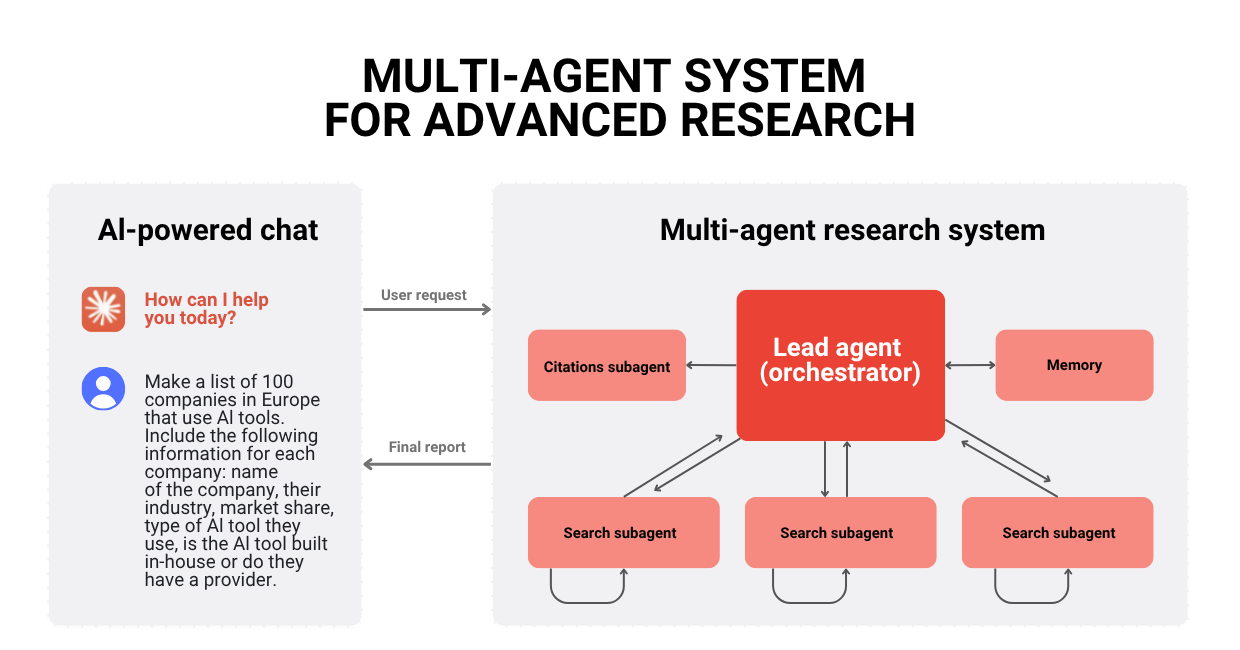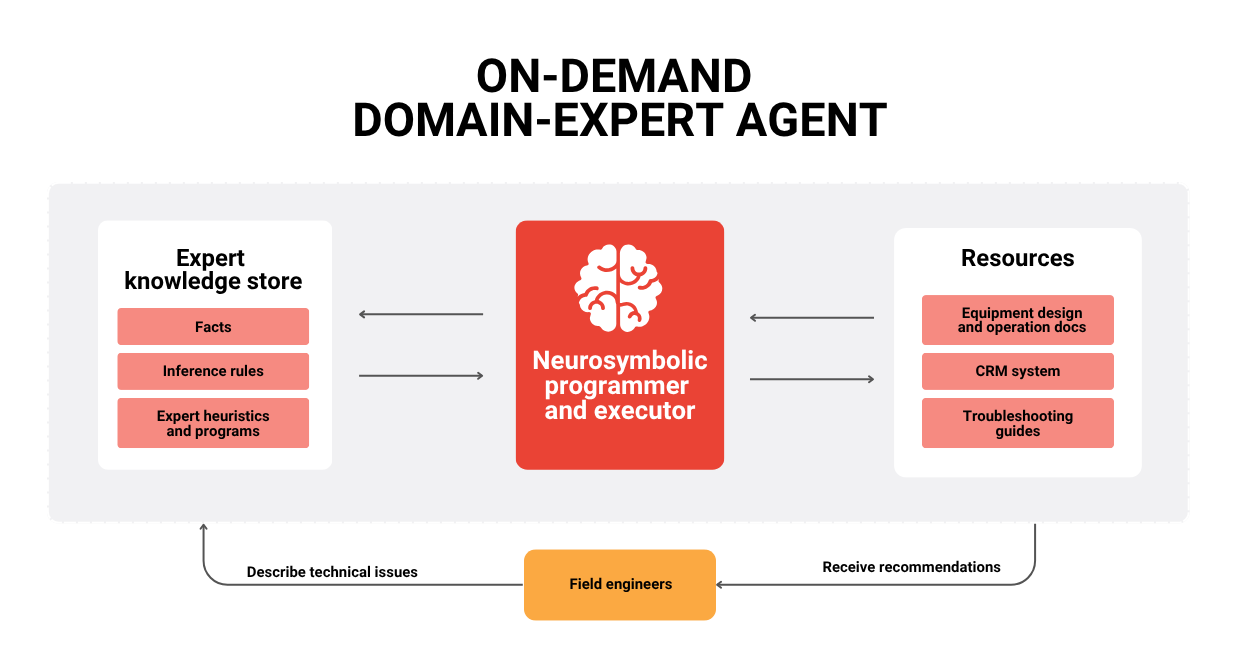From One Smart Assistant to a Team of AI Agents
What if your top-performing team didn’t clock in, didn’t sleep, and could multiply itself to solve several problems simultaneously?
Sounds like a dream for any business, but, in fact, it is a reality for companies that are not afraid to be early adopters and innovate.
Across industries, enterprises are no longer relying on a single smart assistant to do the job. They’re deploying squads of specialized AI agents, each focused, autonomous, and working together to tackle complexity in ways even the best human teams can’t match. From financial forecasting to legacy code refactoring, from personalized in-car experiences to accelerating drug discovery, agentic systems are transforming how work gets done.
Discover how global leaders like Google, OpenAI, BMW, and Johnson & Johnson are unlocking entirely new levels of performance not by replacing people, but by enhancing them with AI agents that learn, reason, collaborate, and scale.
Let’s dive into 9 AI agents use cases that reveal what’s already possible and what’s waiting for businesses next.
Anthropic: Scaling Complex Research with Multi-Agent AI Systems
The Problem
Anthropic needed to enhance its Claude AI model to handle complex, open-ended research tasks across the web and various integrated tools. The one-agent system struggled with ambiguity and the need for parallel exploration.
The Agentic Solution
The company designed a system where a lead agent acts like a project manager, creating subagents to tackle different angles of the same research problem. Each subagent worked with its own tools and queries, feeding insights back to the lead agent, which synthesized the findings.

The Results
Performance skyrocketed. In internal benchmarks, the multi-agent system outperformed single-agent Claude by over 90%. Tasks that required exploring many threads simultaneously, like mapping board members of S&P 500 tech companies, were completed with speed and accuracy that single agents couldn’t match.
OpenAI: Multi-Agent Investment Research for Smarter Portfolios
The Problem
The stakes are high in the world of financial research as one misstep can cost millions. OpenAI wanted to test if agentic systems could improve decision-making in portfolio analysis.
The Agentic Solution
Using their Agents SDK, OpenAI built a collaborative multi-agent AI team of specialists (macro, fundamental, and quantitative analysts), coordinated by a central Portfolio Manager agent. Each agent was treated like a tool: called in for specific tasks, their results reviewed and integrated by the manager.
The Results
Investment reports became more robust, drawing from multiple viewpoints in parallel. Analysts received faster, deeper insights. And because each agent’s role was clearly defined, the system remained transparent and auditable, which is essential in financial settings.
Meta: On-Demand Expert AI Guidance for Engineers
The Problem
Field engineers at a leading semiconductor company struggled to access the in-depth, hands-on knowledge that only decades of experience can provide. Support was inconsistent, slow, and overly dependent on a few senior experts.
The Agentic Solution
Meta-backed Aitomatic developed a Domain-Expert Agent (DXA), powered by Llama 3.1, trained on the company’s internal manuals, notes, and expert interviews. It became a digital mentor, guiding engineers through complex diagnostic workflows.

The Results
The DXA helped engineers resolve issues 3x faster, and achieved a first-try success rate of 75% (compared to 15-20% with generic tools). The company also reduced reliance on overburdened senior staff: a big win for scaling operations.
Shopify: Smarter E-Commerce Listings with Image-Aware Agents
The Problem
Shopify merchants often missed key product attributes or categorized items incorrectly, making it harder for customers to find what they needed.
The Agentic Solution
Shopify fine-tuned a lightweight version of LLaVA (a multimodal LLM) to build two agents: one for real-time attribute tagging during listing creation, and one that works offline to clean up and improve the metadata of billions of products.
The Results
With over 100 GPUs powering it, the system processed tens of billions of tokens daily. Merchants received smarter suggestions, listings became more searchable, and shoppers found what they needed faster. The adoption of AI agents for e-commerce improved user experiences and increased conversion rates, while the company added a scalable, open-source solution that cut operating costs to their stack. If you are curious about ways AI can increase ROI and elevate customer loyalty in retail, read this case study.
McKinsey: Agentic Workflows for Legacy App Modernization
The Problem
A major bank had a tangled mess of over 400 legacy applications. Modernizing them was slow, expensive, and error-prone. Human teams couldn’t keep up.
The Agentic Solution
McKinsey introduced a new model: squads of AI agents, each assigned specific tasks (documentation, refactoring, testing), while human supervisors guided the process like foremen in a factory.
The Results
Early adopter teams saw a 50% reduction in time and effort. Agents handled the heavy lifting, while humans focused on strategy and review, resulting in better quality code and faster delivery.
BMW: Smarter Procurement with Multi-Agent Assistants
The Problem
BMW’s procurement teams had to sift through massive data sets to evaluate supplier offers and manage tenders. It was a time-consuming manual process that has significantly limited the employees’ efficiency.
The Agentic Solution
BMW launched AIconic, a multi-agent AI assistant integrated into their internal AI platform. It supported tasks like offer comparison, tender creation, and knowledge navigation.
The Results
Over 10,000 intelligent searches were conducted by 1,800 employees in a short time. The system was not only fast but evolved from a passive tool into a proactive assistant, which was soon able to flag anomalies and suggest actions before humans even asked.
Autonomous Agents at Johnson & Johnson: AI-Driven Drug Discovery
The Problem
In pharmaceutical development, even small inefficiencies in chemical synthesis can delay time-to-market. One bottleneck was timing solvent switches during crystallization.
The Agentic Solution
J&J built agents that monitored variables like temperature, reactions, and material behavior. These agents could independently decide the optimal timing for switching solvents, which was a critical step in drug crystallization.
The Results
Manual iterations were replaced with faster, AI-driven decisions. Scientists still supervised the process, but the agents significantly reduced trial-and-error, speeding up R&D pipelines and helping new treatments move forward faster.
Uber: On-Call Support Enhanced with Agentic RAG
The Problem
Uber engineers constantly needed quick answers from complex policy documents, but traditional retrieval-augmented generation (RAG) systems often failed to return precise answers.
The Agentic Solution
Uber upgraded to Enhanced Agentic RAG (EAg-RAG). They added agents to optimize queries, select the most relevant sources, and validate final answers before delivering them to users via Slack.
The Results
Response accuracy jumped 27%, and misinformation dropped 60%. This empowered engineers to solve problems without waiting on SMEs, freeing up experts to focus on higher-value tasks. Learn more about ways AI can empower engineers and streamline plant maintenance in our recent case study.
Google: Seamless In-Car Experiences with Intelligent Agents
The Problem
Drivers needed help navigating, messaging, playing media, and checking car functions without distractions.
The Agentic Solution
Google created a suite of voice-driven agents: a Navigation Agent that used Maps data, a Media Agent for personalized music, a Messaging Agent to draft and send updates, and a Car Manual Agent to answer questions like “What does this light mean?”
The Results
The multi-agent collaboration was orchestrated by a central conductor that routed queries, maintained context, and adapted to user needs. The outcome was a seamless in-car experience that felt personalized, intuitive, and safer for drivers on the go.
Upgrade or Get Left Behind
The message behind all these agentic AI use cases is clear: businesses that adopt agentic systems move faster, work smarter, and solve bigger challenges with more precision. The winning strategy today is not about replacing humans, but about extending the capacity of your workforce with innovative solutions.
So, whether you operate in retail, manufacturing, healthcare, or IT, it is time to build teams of AI agents, not just AI tools.
At Zazmic, we help companies adopt AI seamlessly, tailored to your specific goals and industry. Ready to explore the agentic future? Join for our FREE Agentspace and AI Agent Builder workshop today!


